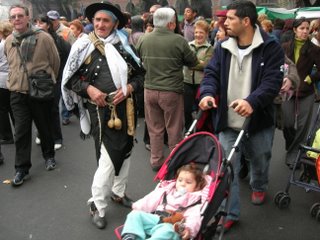 Yesterday we journeyed an hour in a collectivo (bus) to the western suburb of Matadores where a feria is held every Sunday. I met Lorraine and Toni at the apartment across the street where they are staying with a delightful former nun named Moochie who likes to host foreign students in her home. Besides the Cabrillo students, her guests currently include Pascal from Switzerland and Michael from Texas. Amelia from our Santa Cruz contingent joined us and Moochie led the six of us on a journey into the land of the gauchos.
Yesterday we journeyed an hour in a collectivo (bus) to the western suburb of Matadores where a feria is held every Sunday. I met Lorraine and Toni at the apartment across the street where they are staying with a delightful former nun named Moochie who likes to host foreign students in her home. Besides the Cabrillo students, her guests currently include Pascal from Switzerland and Michael from Texas. Amelia from our Santa Cruz contingent joined us and Moochie led the six of us on a journey into the land of the gauchos.The town is named for the slaughterhouse that once were located there. It was once nicknamed Nueva Chicago. Less a flea market than a craft fair, with entertainment, the Matadores Feria featured dozens of booths spread out in the main streets of the town. After checking out the lay of the land, we adjourned to a wonderful corner restaurant and enjoyed a two-hour lunch. The sign on the window said "Hoy Locro," so Amelia and I, being adventurous, tried locro, the speciality of the day. It turned out to be a stew of corn, meat and white beans and utterly delicious. Lorraine and Toni went for the steaks, and Michael and Moochie the pasta (the Italian influx has resulted in some terrific fresh pasta in many restaurants like I had for lunch yesterday).
There were all kinds of crafts for sale, an an usual number of little dolls made out of a variety of materials that appeared to be elves of dwarves. I finally found a mate cup that I liked, with a silver bombilla to drink it through. The others bought gifts. Both Lorraine and Moochie got rain sticks that make a noise like you might hear in a rain forest. Toni bought some gifts. The gauchos were having a riding contest called a sortija, and we went to watch. The horsemen would whip their horses into frantic speeds down a narrow street, stand up in the stirrups and attempt to stick a pencil through a tiny ring hanging from a ribbon while riding at full tilt. Only a few succeeded.
At the center of the feria was a stage which held a succesion of musicians while members of the audience danced in front. One of the traditional dances involved handkerchiefs and looked more like flamenco than the tango. The various groups dances, I learned, have the names chacarera, chamane and the samba, though not the one from Brazil. The latter did apparently involve the seducation of the woman by the man, symbolically of course. Men, young and old, strolled through the crowd in their guacho outfits. The old man picture above was particularly colorful. We went inside a pulperia, or saloon, off the main street where dozens of people were eating at long tables, and we watched a group of dancers perform while a woman sang and a man played guitar. It looked to me something like a square dance with the participants clicking their heels as if they were in Spain. Moochie told me that the music and dancing were "folklorico."
As the day wore on, clouds increased and soon it began to rain. We returned to Buenos Aires by collectivo, standing up most of the way amidst a crowd of porteños. Back at her apartment, Moochie offered off "facturas" -- little pastries she bought at the bakery around the corner -- and, for me, mate. Not in my new cup, for it needs to be properly seasoned (I´ll have to translate the directions which are in Spanish), but in one of her own. Actually the cup is the mate; a "cup of mate" would be an oxymoron. She packed the mate with yerba (pronounced "churba" in Castellano), and poured in very hot water. The social ritual is: you pour, you sip until it gurgles, and you pass the mate along to the next person. The tea is somewhat bitter and very strong. I´m sure it´s an acquired taste. Moochie continued to sip throughout the evening while we talked in English, Spanish, Italian and French. When I got home, Ofelia examined my mate and offered to season it herself. I think it involves letting liquid sit in it for some time to close any holes. But then I haven´t translated the directions yet.
When I arrived home from the Evita museum the day before, I showed Ofelia the literature that I had collected. She frowned. Evita was not her heroine, and she explained why. Rolling up her sleeves, she showed me her wrists which were covered with scars. She told me that she was badly burned when she was 16. But because her father was not a Peronista, a supported of Evita´s husband, Juan Peron, they would not treat her at the local hospital which was one of Evita´s projects. For this, Ofelia can never forgive her. She also told me that Peron was the friend of Nazis and was a fascists himself. So I could see her point and promised to give this perspective to people in the United States.



No comments:
Post a Comment